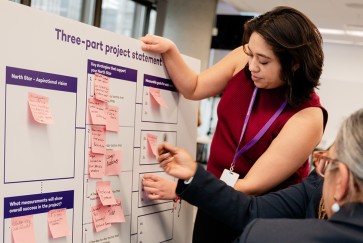An analysis of subscriber data from three big-city news websites by the Medill Local News Initiative at Northwestern University suggests that growing a regular habit is most essential to news organizations cultivating readers who are willing to pay for news.
The study could help guide news organizations attempting to navigate a changing media landscape. As online advertising lags, many local news organizations are shifting their strategy to focus on reader-based revenue models, especially digital subscriptions, as a path to financial sustainability and greater community service.
That pivot is redefining the goals for many news outlets. Rather than chasing viral “clicks” to boost ad revenue, they are trying to establish their value to subscribers.
“This research illustrates a sea change in the relationship between local news organizations and their readers,” said Tim Franklin, a senior associate dean at Northwestern’s Medill School of Journalism, Media, Integrated Marketing Communications and former president of The Poynter Institute.
“Our data analysis shows that in this new era for local news, metrics like page views and time spent on articles — two commonly cited benchmarks — are not nearly as important as the number of readers who are frequent users,” Franklin explained. “With that knowledge, the question then becomes: What are the tools and types of news and information that local outlets can generate to grow a daily reader habit?”
Franklin heads the Medill Local News Initiative, a project that includes this study and other research to help local journalism overcome the industry’s growing crisis. Medill partnered with three news organizations — the Chicago Tribune, Indianapolis Star and San Francisco Chronicle — that provided 13 terabytes of anonymous reader data.
Medill’s Spiegel Research Center conducted the analysis, and Spiegel Research Director Ed Malthouse presented it to the three “learning lab” news organizations at a Northwestern conference in December. The news outlets will continue to work with Northwestern this year, and Medill’s Knight Lab will use the research findings to help create new digital tools and products to bolster local news.
In the new Medill study, researchers found that a regular reader habit and unique local content were key factors in retaining subscribers. The analysis also contained a puzzling surprise: Subscribers who read many stories per visit and read them thoroughly were no more likely to keep their subscriptions than those who skimmed. In some cases, high rates of story reading and time spent per story were associated with people dropping their subscriptions. The reasons for this possible paradox are not clear, and more research is required.
Along with Northwestern’s specific findings, the research approach is significant. By concentrating on subscriptions instead of page views, the study reflects a major strategic transformation, said Tom Rosenstiel, executive director of the American Press Institute.
“What you’re talking about here in this research is really a paradigm shift,” Rosenstiel said. “… ‘My customer is the consumer, and that’s where I get my revenue,’ as opposed to ‘my customer is the advertiser, and I’m leveraging my readers to these advertisers.’ It’s a big shift, a huge kind of shift in mission.”


